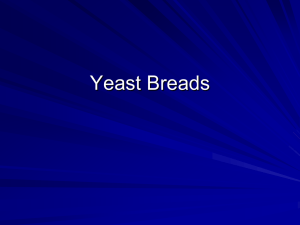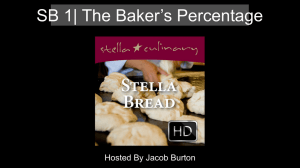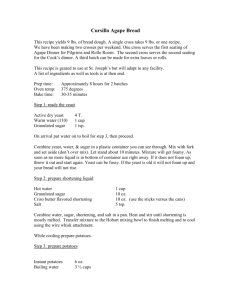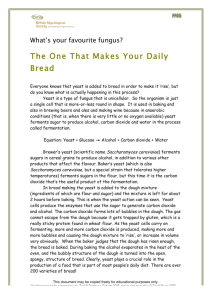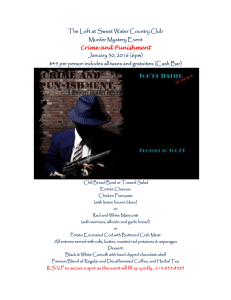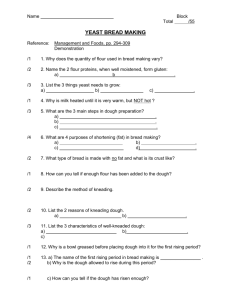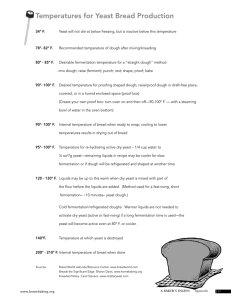The Simple Pleasure of Homemade Bread
advertisement
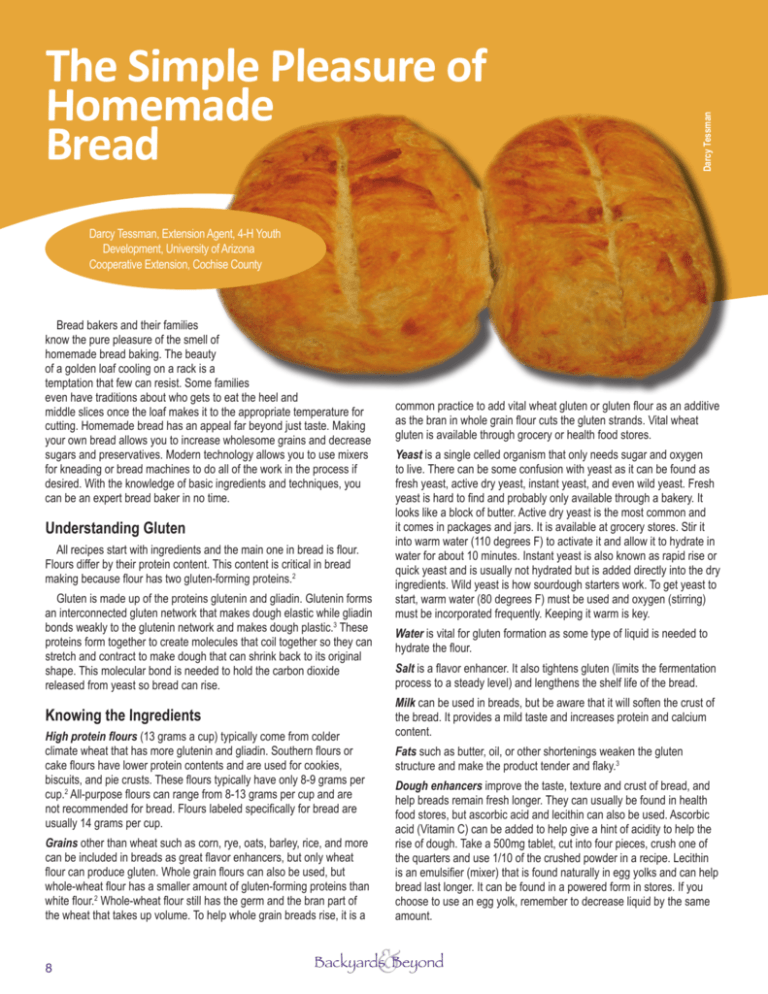
Darcy Tessman The Simple Pleasure of Homemade Bread Darcy Tessman, Extension Agent, 4-H Youth Development, University of Arizona Cooperative Extension, Cochise County Bread bakers and their families know the pure pleasure of the smell of homemade bread baking. The beauty of a golden loaf cooling on a rack is a temptation that few can resist. Some families even have traditions about who gets to eat the heel and middle slices once the loaf makes it to the appropriate temperature for cutting. Homemade bread has an appeal far beyond just taste. Making your own bread allows you to increase wholesome grains and decrease sugars and preservatives. Modern technology allows you to use mixers for kneading or bread machines to do all of the work in the process if desired. With the knowledge of basic ingredients and techniques, you can be an expert bread baker in no time. Understanding Gluten All recipes start with ingredients and the main one in bread is flour. Flours differ by their protein content. This content is critical in bread making because flour has two gluten-forming proteins.2 Gluten is made up of the proteins glutenin and gliadin. Glutenin forms an interconnected gluten network that makes dough elastic while gliadin bonds weakly to the glutenin network and makes dough plastic.3 These proteins form together to create molecules that coil together so they can stretch and contract to make dough that can shrink back to its original shape. This molecular bond is needed to hold the carbon dioxide released from yeast so bread can rise. Knowing the Ingredients High protein flours (13 grams a cup) typically come from colder climate wheat that has more glutenin and gliadin. Southern flours or cake flours have lower protein contents and are used for cookies, biscuits, and pie crusts. These flours typically have only 8-9 grams per cup.2 All-purpose flours can range from 8-13 grams per cup and are not recommended for bread. Flours labeled specifically for bread are usually 14 grams per cup. Grains other than wheat such as corn, rye, oats, barley, rice, and more can be included in breads as great flavor enhancers, but only wheat flour can produce gluten. Whole grain flours can also be used, but whole-wheat flour has a smaller amount of gluten-forming proteins than white flour.2 Whole-wheat flour still has the germ and the bran part of the wheat that takes up volume. To help whole grain breads rise, it is a 8 common practice to add vital wheat gluten or gluten flour as an additive as the bran in whole grain flour cuts the gluten strands. Vital wheat gluten is available through grocery or health food stores. Yeast is a single celled organism that only needs sugar and oxygen to live. There can be some confusion with yeast as it can be found as fresh yeast, active dry yeast, instant yeast, and even wild yeast. Fresh yeast is hard to find and probably only available through a bakery. It looks like a block of butter. Active dry yeast is the most common and it comes in packages and jars. It is available at grocery stores. Stir it into warm water (110 degrees F) to activate it and allow it to hydrate in water for about 10 minutes. Instant yeast is also known as rapid rise or quick yeast and is usually not hydrated but is added directly into the dry ingredients. Wild yeast is how sourdough starters work. To get yeast to start, warm water (80 degrees F) must be used and oxygen (stirring) must be incorporated frequently. Keeping it warm is key. Water is vital for gluten formation as some type of liquid is needed to hydrate the flour. Salt is a flavor enhancer. It also tightens gluten (limits the fermentation process to a steady level) and lengthens the shelf life of the bread. Milk can be used in breads, but be aware that it will soften the crust of the bread. It provides a mild taste and increases protein and calcium content. Fats such as butter, oil, or other shortenings weaken the gluten structure and make the product tender and flaky.3 Dough enhancers improve the taste, texture and crust of bread, and help breads remain fresh longer. They can usually be found in health food stores, but ascorbic acid and lecithin can also be used. Ascorbic acid (Vitamin C) can be added to help give a hint of acidity to help the rise of dough. Take a 500mg tablet, cut into four pieces, crush one of the quarters and use 1/10 of the crushed powder in a recipe. Lecithin is an emulsifier (mixer) that is found naturally in egg yolks and can help bread last longer. It can be found in a powered form in stores. If you choose to use an egg yolk, remember to decrease liquid by the same amount. & Backyards Beyond Sugar feeds yeast, but if there is more than 1 tablespoon of sugar per cup of flour the gluten will suffer in the recipe.2 Sweet breads are rare, but breads with sweet fillings exist. So, leave the sugar for after the dough has been made. The ingredients in bread are basic and easily found in your local grocery store. What you choose to put into the bread you bake for your family is limited only by your own creativity. As the focus moves to the techniques for making bread, you may find a new and different way to make a family favorite. Mixing Techniques for Making Bread Dough Autolysis is a technique of hydrating the flour and water in a recipe for 15-30 minutes. Place the water and the flour in mixer, mix for about 2030 seconds just to blend and cover with plastic wrap and let sit. Then add the remaining ingredients, mix just to form a ball. There is no need to knead the dough as the hydration process begins gluten formation. Let rise. Follow the instructions for the remainder of the recipe. Straight dough is the traditional method of dough making. Mix the ingredients, allow the dough to rise, punch it down, shape the dough, allow it to rise again, and bake it. Pre-ferments are a “culture” or “starter” like sourdough. As starters begin to ferment they produce acid that helps yeast work faster and longer. There are several types of pre-ferments and each is used to increase the flavor of the bread. A sponge is a fairly firm mixture of yeast, flour and liquid that is allowed to stand for several hours. The poolish (see photo of jar with starter) is a wetter mixture with yeast and equal weights of flour and water.2 Recipes will call for a starter; however a poolish can be adjusted from any recipe. Take 1/8 teaspoon yeast, 1/2 cup warm water and 1 cup of flour and mix for one minute. Cover and let sit for several hours, or overnight. In the morning, continue the bread making process, adjusting for the flour, yeast and water used. Compare the flavor of that loaf of bread to a loaf of the same recipe made without the poolish technique. This technique is best used on artisan breads that desire large holes such as cibatta and focaccia. Baking Techniques Probably the most important factor in determining the taste of bread is the baking technique.1 Bread can be baked in a 350 degree dry oven for an hour for a tender crust. Or, artisan bread is most often baked in a 400-450 degree oven that gets a burst of steam from a cup of water poured into a hot baking pan at the moment the bread is put in. Hotter ovens mixed with steam produce a thicker crisper crust that crackles such as on a baguette. Whether you bake one loaf a week, month or season, knowing the basics about ingredients and techniques allows you to experiment until you find the perfect fit for your family. The next time you are in the grocery store aisle, you can stock up on bread flour and active dry yeast, and plan to make homemade pizza, bread bowls for dip, or a loaf of wheat bread for peanut butter and jelly. Whatever you make, enjoy the pleasure that comes from making a great loaf of bread. Cauvain, S.P. & Young, L.S. (2007). Technology of Breadbaking. NewYork, NY 10020:Springer Science. Corriher, S. O. (2008). BakeWise. NewYork, NY 10020: Scribner. 3 McGee, H. (2004). On Food and Cooking: The Science and Lore of the Kitchen (2nd ed.). New York, NY 10020: Scribner. (Original work published 1984) 1 Darcy Tessman Darcy Tessman 2 Spring 2010 2010 Summer 99
